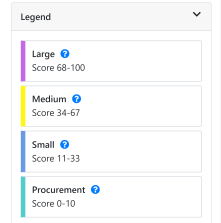When it comes to project management, most companies use the equivalent of a steam roller: A 200-page project management manual that implements a staged development process with several ‘capital gates'. This complex approach ensures projects are well-defined and structured, assesses realistic costs and considers all risks before funding is approved.
The manual and its associated spreadsheets are excellent for large projects, requiring a heavy handed approach to manage their inherent risk and complexity. However, they are wildly over-engineered for the 80-90% of capital projects (by number) that fall into the ‘small' category.
Small projects require a substantially less intricate development process for managing projects than large, strategic projects. They don't need to have a three-phase development lifecycle forced upon them.
Also, most small projects are managed by someone who already has a day job – and who may have little project management experience. These people don't have time to decipher which part of the manual logically applies to their conveyor upgrade. But they might aspire to broaden their skillset into project management, so guidance is sought to show the key project management steps including the relevant risk management measures needed.
In practice, what happens is that many of those managing small projects often use the project management manual as a doorstop in the planning phase. Instead of considering the specific project management life cycle, they implement a rinse-and-repeat delivery approach based on their last project, resulting in variable outcomes. When they do attempt to use the ‘large' lifecycle, it results in widespread inefficiency and confusion.
“Small projects account for around 30% of a capital project portfolio by value, which leaves a significant amount of multi-million dollar investment without effective management.”
Classify projects lifecycles by complexity and guide your project managers through development.

Instead of trying to crack a nut with a steam roller, organisations need a consistent framework to classify the type of project involved.Only then can it be assigned an appropriate lifecycle for its complexity.
CAPEXinsights scores projects based on tailored complexity criteria in the project planning phase and then assigns the right type of development life cycle – complete with workflow actions and project management plan for key project stakeholders.
Measuring project complexity for effective project management

The platform allows organisations to include a range of tailored criteria.
For example, as well as standard HSE questions, project managers may be asked:
• How well-defined is the business objective?
• Is this type of project new to the site?
• Does it involve using technology that is new to the world/business/site?
Project lifecycle management for successful projects
With the scoring complete, the platform not only instantly assigns an appropriate lifecycle, but it guides the Project Manager through the process with step-by-step instructions, templates, forms, and checklists that bring existing processes to life. The system offers clear guidelines and an effective project management framework rather than requiring initial prescriptive input to classify a project. This common-sense flexibility gives your Project Manager enough support to meet the project's objectives – no matter the scope of their role.
With the project scope defined, your Project Manager is supported to go from project planning to through to the project execution phase with the relevant key project management steps outlined. This supports the business case that with the proper guard rails to deliver projects consistently, your organisation can reach its strategic goals.
The platform can also act as a learning tool, offering the inexperienced Project Manager a wealth of resources, including explanations, links to policies, and connections with Subject Matter Experts they can approach with questions throughout the project management phases. Over time, this helps organisations expand their project management capability, amplifying the organisational project management maturity and overall project performance.
Project Managers are encouraged to attach evidence to show action steps have been completed, making oversight fast and easy in the monitoring phase. Governance is also supported by connecting key stakeholders throughout the phases of the project - enabling them to share information easily and track progress across the entire project.
Those favouring the steam roller approach say all projects must be put through the manual. But this is hard to enforce and highly inefficient for small projects, not to mention open to interpretation for inexperienced project teams.
Project Managers who are armed with the right project documentation to manage small projects efficiently are more likely to be delivering projects effectively. And those with little experience are given consistent guidelines and best-practice support to achieve their project deliverables and the skills to work on future projects.
For more information on how CAPEXinsights can simplify your business processes and help you achieve your capital project and portfolio potential, please don’t hesitate to reach out to us.